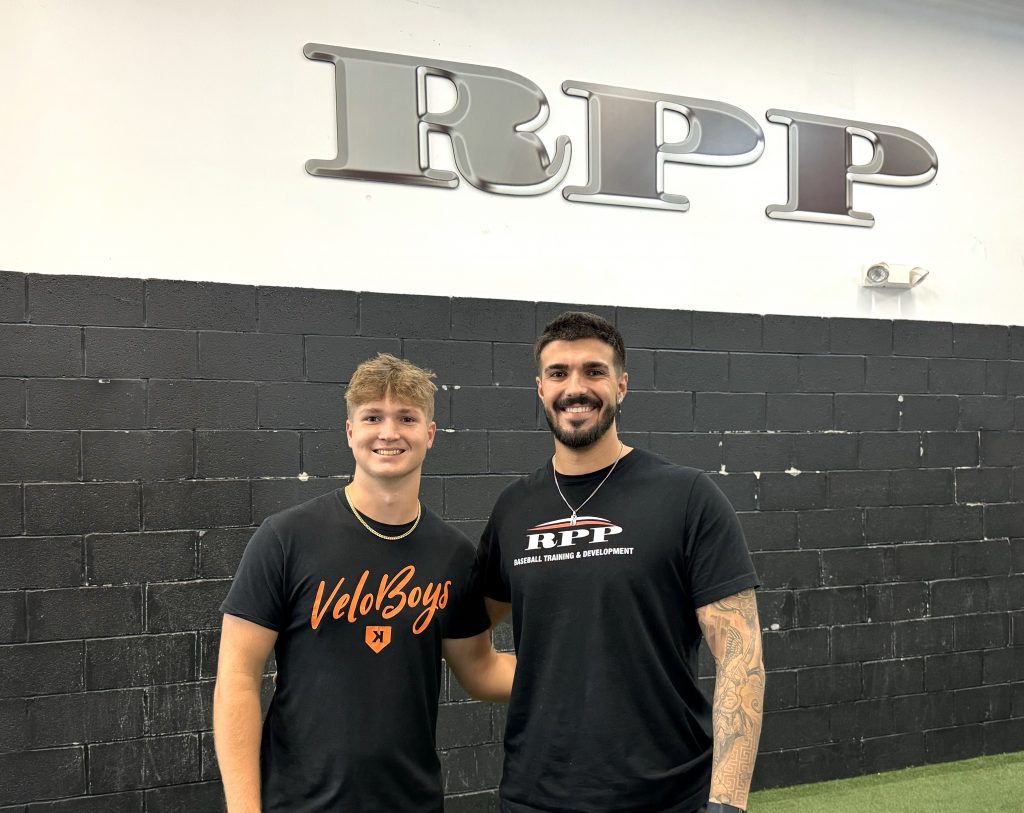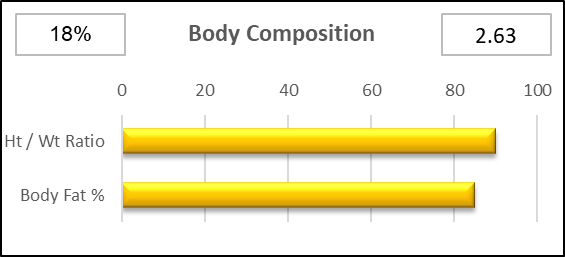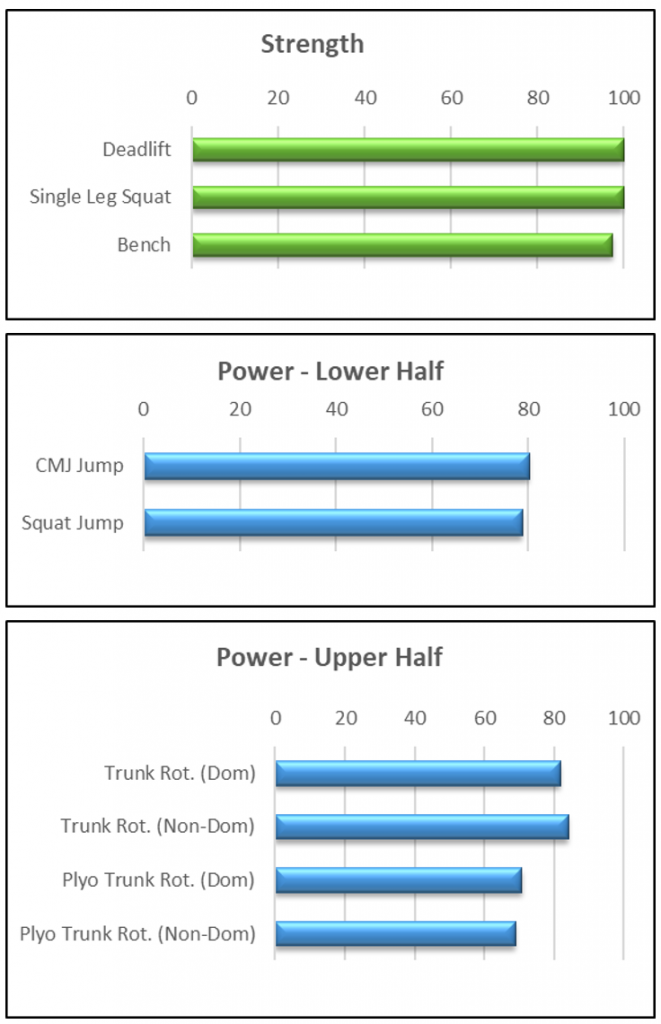
West Point commit and rising Junior, 6’2” RHP Quinn Miller joined RPP in September 2022. In June 2022, prior to his start at RPP, he was clocked at 81 mph at a PBR event. By the end of our winter-training program in February 2023, Quinn touched 85.5 mph at another PBR event. Unfortunately, during the summer of 2023 Quinn had to have TJ Surgery. After a year of hard work, both inside the weight room and inside the nets, Quinn recently hit a PR of 90+ mph.
How did he do it?
For the purposes of this write-up, we are going to focus on Quinn’s training post his TJ surgery.
Returning from TJ surgery has several different components that need to be considered and orchestrated together to get the athlete back to game-form without any setbacks:
-
- Physical Therapy (PT)
- Strength Training
- Throwing
- Pitching
Bouncing back successfully from TJ is about a steady progression over many months with input from all parties involved. We generally like to see athletes begin strength training as early as 3-4 weeks post-op and Quinn was back at it within that time frame. This allowed us to begin working on the remainder of his body (excluding the arm) so that once we could begin re-training his arm, we weren’t looking at a completely de-conditioned athlete.
Returning to the weight room is usually done in conjunction with the work they are doing with their PT. It is important to note that every athlete’s timeline is different for many reasons. Because there is individual variability in all throwing athletes, there is no set timetable for completion of the program.
Although there are several different types of surgery options for TJ, the timeline outline below is for a full reconstruction of the UCL (a “bracing” will generally have a quicker back to play timeline). Here is a rough breakdown of the timeline we use TJ athletes and Quinn’s was quite similar.
Month 1 (beginning 3 weeks after post-op):
-
- Full body workout 3x’s/week (eccentric training is used on the good arm only to help with “cross-education” to the other)
- Mobility work
- No plyometrics (due to the risk of falling)
- NO throwing
Month 2
-
- The injured arm is still not being utilized yet, but strength training continues, and volume is increased by using “split days”
- Max strength and mobility work continues
- No plyometrics
- NO throwing
Month 3
-
- By now, generally, the athlete has been cleared to train the other arm from a strength standpoint
- Full-body strength work continues
- Low-level plyometrics are introduced
- NO throwing
Months 4-8
Strength Training – At this point, there should be no more restrictions on strength training, unless informed otherwise by the PT / Dr. This means that our timeline for getting the athlete physically ready for in-game performance will begin. Which strength phase an athlete starts in will be based primarily on the physical condition of the athlete and their “lowest hanging fruit”, whether it be strength or power.
Throwing Program (Phase 1) – Generally, somewhere around the 5th month, you can begin a back-to-throw program with weekly increases in intensity. We refer to this as Phase, a 10-12 step process, and it should be on flat ground only. It consists of throwing at each step 2 to 3 times per week without pain or symptoms before progressing to the next step or unless otherwise specified by the physician. The object of each step is for the athlete to be able to throw the ball without pain at the specified distance (45 ft., 60 ft., 90 ft., and 120 ft.) and intensities for that step with the use of a radar gun. Intensities need to be prescribed so that the athlete follows a rigid progression and does not overdo it.
Months 9-12
Strength Training – From a timing standpoint, by now the athlete should be on a periodized training program similar to any healthy athlete.
Throwing Program (Phase 2) – In Phase 2, if the athlete can throw to the prescribed distance without pain he should be ready for throwing off the mound or return to their respective position. At this point, full strength and confidence should be restored in the athlete’s arm. Just as the advancement to this point has been gradual and progressive, the return to unrestricted throwing must follow the same principles. A pitcher should first throw only fast ball at 50%, progressing to 75% and 100%. When the athlete reaches 100% on his FBs, he can start more stressful pitches such as breaking balls. If all goes well with no minor setbacks, it is possible for an athlete to be back to play within 12 months.
Quinn’s Return to the Mound
Overall Physicality
Quinn was recently reassessed, and he has made great strides, both physically and mechanically. He’s weighing in at 192 lbs. vs. 179 lbs. in February 2023, with a 2.63x body weight to height ratio, which is well within our desired range for high performance athletes at 18% BF.

Strength and Power
The following is a summary of his recent strength, and lower and upper half power metrics. They have improved significantly, now attaining elite levels for a junior in high school.

Pitching Mechanics
Quinn’s final pitching eval prior to his surgery highlighted the following improvements he had made and disconnects he still needed to work on:
-
- Improvements – Late arm issues and early trunk rotation
- Still needed work – Using his lower half better which was creating other issues downstream such as lateral trunk tilt and an unstable front leg.
Unfortunately, TJ delayed addressing some of these issues until he could get back on the mound.
One issue that needed to be addressed was his overall athleticism and fluidity of his delivery. Most times guys who get TJ come back a little hesitant with some mechanical guardrails mostly due to the fear of getting injured again. Going through some light intensity throwing progressions in his long-toss and flat ground phase helped him get a better gauge of the intensity needed to deliver the ball at a high velocity without putting too much pressure on his throwing arm.
A major point to mention comes from Quinn’s most recent pitching eval. His new eval showed significant improvements in his mechanics across the board, mostly due to significant gains in strength which in turn led to better mobility and stability. This increase in overall strength and athleticism allowed him to make better use of his lower half which helped improve the timing / sync of his trunk movement with his lower half when coming down the mound.
We see this time and again with young athletes coming in to rehab TJ. Gains in athleticism and strength while rehabbing the arm create better movers and can often address many mechanical issues prior to even working on mechanics.
Conclusion
In October 2022, just after joining RPP, Quinn was clocked at 79 mph at a PG event. By the following spring, prior to TJ, Quinn was generally sitting low to mid-80s.
A year later, after putting in a significant amount of work since his injury, the results are starting to coming in. He recently touched 90+ mph on the Trackman in-house. And let’s not forget he’s just a junior in high school!
Congrats on the comeback Quinn.
Much more to come here from the junior…
